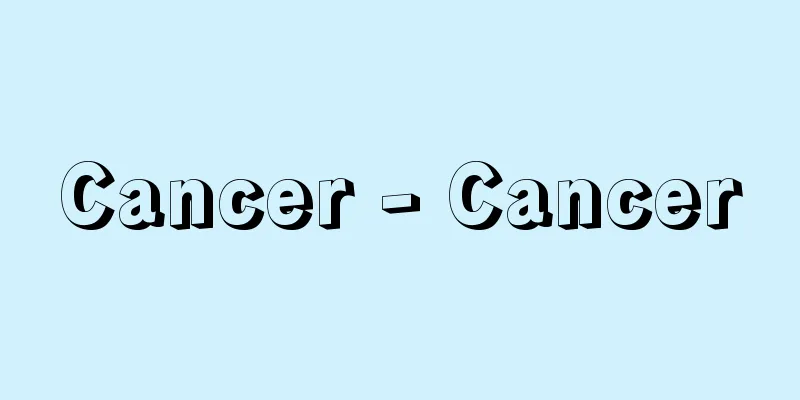Cancer - Cancer

|
Normal cells perform differentiated functions under the control of the body, but when irreversible changes occur and cells begin to grow autonomously, they are called tumor cells. Among these, malignant tumors are those that change into undifferentiated cell shapes, grow rapidly, invade the surrounding area, or metastasize (spread to other organs via lymphatic or bloodstream, or disseminatedly) and eventually kill the host. Pathologically, they are divided into carcinomas and sarcomas in the narrow sense based on the tissue in which they originate. The former refers to those that originate from epithelial tissues such as skin, mucous membranes, and glandular epithelium, while the latter refers to those that originate from non-epithelial tissues (bones, muscles, connective tissues, blood vessels, lymphatic tissues, etc.). Cancer is also found in plants and various animals, but in humans, there are stomach cancer, uterine cancer, breast cancer, laryngeal cancer, lung cancer, liver cancer, esophageal cancer, rectal cancer, etc., and the frequency of cancer by organ varies depending on race and sex. In Japanese people, cancer of the digestive system, such as stomach and liver, is common, and uterine cancer is particularly common in women, but in recent years, lung cancer has been increasing. According to recent statistics on causes of death in Japanese people, cancer is the number one cause of death, surpassing cerebrovascular disorders and heart disease. The overwhelming majority of cases occur in people over 40 years old. Characteristics of cancer cells include abnormalities in the size and shape of the cell nucleus, changes in DNA content, enlargement of nucleoli, and abnormal nuclear division images. These changes are called atypical changes. Even with the same cancer cells, there are differences from relatively differentiated adenocarcinoma and squamous cell carcinoma to simple cancer that is so undifferentiated that it is difficult to distinguish it from sarcoma, and generally the more undifferentiated the cancer, the more atypical it is. Cancer cells deprive the host of nutrients and produce a certain type of toxin (toxohormone), which leads to a state of general weakness known as cachexia. The cause of cancer is still unclear, but it cannot be denied that there is a genetic predisposition. Possible external factors include physical stimuli (such as radiation), chemical stimuli (carcinogens), and viral infections (cancer viruses). In 1970, M. Temin and D. Baltimore discovered that RNA-type cancer viruses contain an enzyme (reverse transcriptase) that synthesizes DNA using RNA as a template. This revealed that structural changes in DNA are related to the carcinogenesis of cells. In addition, it was previously believed that carcinogenesis occurs when a carcinogen acts on a cell, but recently it is believed that a substance called an initiator first alters the cell's DNA, and then a promoter (a substance that promotes carcinogenesis) acts on the cell before the cell becomes cancerous. Therefore, depending on the combination of initiator and promoter, cancer may or may not occur. In reality, it is nearly impossible to identify all initiators and promoters and know their combinations, so research is needed to suppress or inactivate their carcinogenicity. Diagnosis is generally by X-ray examination, CT scan, gastroscopy and other endoscopy, cytology, etc. Immunotherapy is being actively researched as a treatment for cancer, following surgery, chemotherapy, and radiation therapy. There are three types of immunotherapy: active immunotherapy, in which a tumor cell vaccine is introduced into the patient together with an immune enhancer; passive immunotherapy, in which antisera against tumor cells, sensitized lymphocytes, immune RNA, etc. are introduced into the patient; and nonspecific immunotherapy, in which various immune enhancers are administered to the patient to nonspecifically enhance the patient's immune function. Attempts have been made to use live BCG bacteria by GL Morton et al. in the United States, and BCG-CWS by Yuichi Yamamura et al. in Japan. A vaccine made from human tuberculosis bacteria (called the Maruyama vaccine after its discoverer, Chisato Maruyama) has also been used as a treatment, but in August 1981, the Pharmaceutical Affairs Council determined that its effectiveness had not been proven, and its approval as a drug was rejected. →Cancer prevention drugs/anticancer drugs [12 rules for preventing cancer] These are precautions for daily life to prevent cancer, proposed by the National Cancer Center. They were created based on various epidemiological surveys, and the contents are as follows. (1) Eat balanced nutrition Foods contain both cancer-causing and cancer-suppressing substances. For example, eating too much fat can lead to breast and colon cancer, but vitamins A, B, C, and E and dietary fiber have anti-cancer effects. Therefore, it is important to offset the effects of carcinogens in food by eating as many different foods as possible. (2) Eating large amounts of the same foods every day increases the risk of cancer. (3) Avoid overeating: In an experiment with mice, the group that restricted their food intake to about 60% of their usual amount had a lower cancer rate and lived longer than the group that was allowed to eat as much as they wanted. (4) Drink alcohol in moderation: According to a World Health Organization (WHO) study, excessive drinking is known to be related to oral cancer, pharyngeal cancer, and esophageal cancer. (5) Do not smoke or allow others to smoke: In a 12-year study of Japanese men over 40, those who smoked 25 or more cigarettes a day had a mortality rate of 90 times higher for pharyngeal cancer and 7 times higher for lung cancer than non-smokers. It has also been found that wives whose husbands smoke 20 or more cigarettes a day have a lung cancer death rate more than twice as high, even if they themselves do not smoke. (6) Eat an adequate amount of vitamins and fiber. Beta-carotene and vitamin A, which are found in green and yellow vegetables, as well as polyphenols, vitamin C, and vitamin E, which are found in green tea and green and yellow vegetables, have the effect of preventing the development of cancer. Dietary fiber also reduces the risk of colon cancer. (7) Avoid salty foods, and let hot foods cool before eating. Stomach cancer is more common in areas where salt intake is high, and esophageal cancer is more common in areas where hot tea porridge is eaten. (8) Avoid burnt parts. When fish or meat is grilled and burnt, it produces substances that cause mutations in bacteria. (9) Do not eat moldy foods. Mold that grows on nuts and corn is highly carcinogenic. (10) Avoid too much sunlight. Ultraviolet rays are harmful to the skin and can cause skin cancer. (11) When animals are exposed to stress and given a carcinogen, they have a higher incidence of cancer than when they are given only the carcinogen. Also, people who sit at work all day have a higher incidence of colon cancer. (12) In areas where there are insufficient facilities for washing the body, there are more cases of skin cancer and cervical cancer. → Related topics Malignant lymphoma | Ikigai therapy | Wilms' tumor | Werner's syndrome | Cancer genes | Carcinomatous pleurisy | Carcinomatous peritonitis | Basic Law for Cancer Control | Cancer-like disease (medicine) | Cancer suppressor genes | Palliative care | Testicular tumor | Melanoma | Psycho-oncology | Cytology | CDC | Choriocarcinoma | Tumor | Childhood cancer | Intraepithelial carcinoma | Kidney cancer | Pancreatic cancer | Super antigen | Adult disease | Precancerous condition | Occult blood reaction | Colon polyp | Combination therapy | Biliary tract cancer | Electromagnetic interference | Head and neck cancer | Sarcoma | Pneumocystis carinii pneumonia | Leukemia | Opportunistic infection | Ascites | Pain clinic | Radiation therapy | Adjuvant chemotherapy | Holistic medicine | Microwave coagulation therapy | Maruyama Chisato | Maruyama vaccine | Routh | Particle beam therapy | Retrovirus Source : Heibonsha Encyclopedia About MyPedia Information |
|
正常の細胞は生体の制御を受けて,それぞれ分化した機能を営んでいるが,その細胞が不可逆的な変化によって,自律的に増殖するようになったものを腫瘍(しゅよう)細胞という。そのうちで特に未分化な細胞の形に変わり,急速な発育と周囲への浸潤や転移(リンパ流,血流を介し,または散布性に他の臓器へ飛火すること)を起こし,やがて宿主を死に至らしめるような悪性腫瘍を癌という。病理学的にはその発生した組織から狭義の癌腫と肉腫に分ける。前者は皮膚,粘膜,腺上皮などの上皮性組織から発生したものをいい,後者は非上皮性組織(骨,筋肉,結合組織,血管,リンパ組織など)から発生したものをいう。 癌は植物や各種動物にもみられるが,ヒトでは胃癌,子宮癌,乳癌,喉頭癌,肺癌,肝癌,食道癌,直腸癌などがあり,臓器別の頻度(ひんど)は人種および性別により差がある。日本人では一般に胃,肝臓などの消化器系の癌が多く,女性では特に子宮癌が多いが,近年肺癌が増加の傾向にある。癌は最近の日本人の死因統計では脳血管障害,心疾患をこえ第1位である。発生年齢は40歳以上が圧倒的に多い。 癌細胞の特徴としては,細胞核の大きさや形の異常,DNA量の変化,核小体の肥大,異常な核分裂像などがみられる。こうした変化を異型性変化という。同じ癌細胞でも,比較的分化した腺癌,扁平上皮癌から肉腫と区別が困難なほど未分化な単純癌まで差があり,一般に未分化なものほど異型性が強い。癌細胞は宿主からの栄養奪取とともに,ある種の毒素(トキソホルモン)をつくって悪液質という全身の衰弱状態をもたらす。癌の原因はまだ明らかでないが,遺伝的素因があることは否定できない。外因としては,物理的刺激(放射線など),化学的刺激(発癌物質),ウイルス感染(癌ウイルス)などが考えられている。1970年M.テミン,D.ボルティモアはRNA型癌ウイルスの中にRNAを鋳型としてDNAを合成する酵素(逆転写酵素)があることを発見。このことからDNAの構造変化が細胞の癌化に関係していることが明らかになった。また,従来は発癌物質細胞に作用すると癌化が起こるとされていたが,最近ではまずイニシエーターという物質が細胞のDNAを変質させ,次にプロモーター(発癌推進物質)が作用してはじめて細胞が癌化すると考えられている。したがってイニシエーターとプロモーターの組合せ次第では癌になったりならなかったりする。実際にはすべてのイニシエーター,プロモーターを究明し,その組合せを知ることは不可能に近く,これらの発癌性を抑止あるいは不活性化する研究が必要である。 診断は,一般にX線検査,CTスキャン,胃カメラその他の内視鏡,細胞診などによる。癌の治療には,外科療法,化学療法,放射線治療についで免疫療法が盛んに研究されている。免疫療法には腫瘍細胞ワクチンを免疫強化剤とともに患者に移入する能動的免疫療法,腫瘍細胞に対する抗血清,感作リンパ球,免疫RNAなどを患者に移入する受動的免疫療法,各種の免疫強化剤を患者に投与して患者の免疫機能を非特異的に増強する非特異的免疫療法がある。米国のG.L.モートンらのBCG生菌,日本の山村雄一らのBCG-CWSなどが試みられている。また,人型結核菌からつくられたワクチン(発見者の丸山千里にちなんで丸山ワクチンという)が治療薬として用いられているが,1981年8月の薬事審議会で有効性が立証されないと判定され,医薬品としての認可が否決された。→癌予防薬/制癌薬〔癌を防ぐための12ヵ条〕 癌を予防するための日常生活の注意事項で,国立がんセンターが提唱している。さまざまな疫学調査などをもとに作成されたもので,内容は以下の通り。(1)バランスのとれた栄養を摂る食品には癌を引き起こす物質と癌を抑える物質がともに存在している。たとえば,脂肪を摂りすぎると乳癌や大腸癌になる危険性があるが,ビタミンA・B・C・Eや食物繊維には発癌抑制の効果がある。したがって,できるだけ多くの種類の食品を摂ることによって,食物中の発癌物質の作用を相殺することが大切である。(2)変化のある食生活を同じ食品ばかり大量に毎日食べると,癌になるリスクが高くなる。(3)食べ過ぎを避けるネズミの実験によると,好きなだけ食べさせたグループよりも,食事量を60%ほどに制限したグループのほうが発癌率が低く,長生きするという結果が出ている。(4)お酒はほどほどに世界保健機関(WHO)の調査によると,過度の飲酒と口腔癌,咽頭癌,食道癌に関係があるとわかっている。(5)タバコを吸わない,吸わせない40歳以上の日本人男性を12年間調査したところ,1日25本以上タバコを吸う人は,吸わない人と比べて,咽頭癌が90倍以上,肺癌が7倍以上の死亡比になった。また,1日20本以上タバコを吸う夫をもつ妻は,自分で吸わなくても肺癌の死亡率が2倍以上高いことがわかっている。(6)適量のビタミンと繊維質をよく摂る緑黄色野菜に多く含まれるベータ・カロチン,ビタミンA,緑茶や緑黄色野菜に含まれるポリフェノール,ビタミンC,ビタミンEは,癌の発生を防ぐ作用がある。また,食物繊維は大腸癌にかかりにくくする。(7)塩辛いものを避けて,熱いものは冷ましてから食べる塩分の摂取が多い地域に胃癌,熱い茶粥(ちゃがゆ)を食べる地域に食道癌が多い。(8)焦げた部分は避ける魚や肉を焼いて焦がすと,細菌などに突然変異を引き起こす物質が生じる。(9)カビの生えたものは食べないナッツ類やトウモロコシにつくカビには強い発癌性がある。(10)日光に当たりすぎない紫外線は皮膚に有害であり,皮膚癌の原因になる。(11)ストレスをためず,適度にスポーツを発癌物質を与えた動物にストレスを与えると,発癌物質だけを与えた場合よりも癌の発生率が高くなる。また,1日中座って仕事をしている人に大腸癌が多い。(12)身体を清潔にする身体を洗う設備が不十分な地域には,皮膚癌,子宮頸癌が多い。 →関連項目悪性リンパ腫|生きがい療法|ウイルムス腫瘍|ウェルナー症候群|癌遺伝子|癌性胸膜炎|癌性腹膜炎|がん対策基本法|がんもどき(医学)|癌抑制遺伝子|緩和ケア|睾丸腫瘍|黒色腫|サイコオンコロジー|細胞診|CDC|絨毛上皮腫|腫瘍|小児癌|上皮内癌|腎癌|膵癌|スーパー抗原|成人病|前癌状態|潜血反応|大腸ポリープ|多剤併用療法|胆道癌|電磁波障害|頭頸部癌|肉腫|ニューモシスチス・カリニ肺炎|白血病|日和見感染症|腹水|ペインクリニック|放射線治療|補助化学療法|ホリスティック医療|マイクロ波凝固治療|丸山千里|丸山ワクチン|ラウス|粒子線治療|レトロウイルス 出典 株式会社平凡社百科事典マイペディアについて 情報 |
<<: Kan-aoi (Winter Flower) - Heterotropa nipponica
Recommend
Katsura Bunraku
Rakugo performer. The first was the Edo-style Bun...
Inakama - Inakama
〘Noun〙① One of the measurements for the space betw...
Winning horse betting ticket - Winning horse betting ticket
Also called a betting ticket. There are five types...
Nihon-daira
This refers to the flat land at the summit of Mt....
Nirvana Buddha
This reclining statue shows Shakyamuni sleeping af...
Han-bei (Han-bei)
Inscriptions from the Han dynasty in China. There ...
Gopāla (English spelling) Gopala
...a dynasty that ruled Bengal, India, from the m...
Bonneval, CAde (English spelling) BonnevalCAde
…French nobleman born Claude Alexandre de Bonneva...
Yi Sǔng-hun (English spelling)
Born: 1756, 32nd year of King Yeongjo's reign....
Etchu Province - Etchu no Kuni
The old name of the province that covers the enti...
Oxysuccinic acid
...A type of hydroxy acid (oxycarboxylic acid), i...
Aglaonema commutatum (English name) Aglaonemacommutatum
… [Takabayashi Masatoshi]. … *Some of the termino...
Asagi curtain - Asagimaku
A type of curtain used in Kabuki plays. It is ligh...
Petraeus, E. (English spelling) PetraeusE
...His translation of the New Testament (1548) la...
Urban Agriculture
Urban agriculture is a type of agriculture that i...









